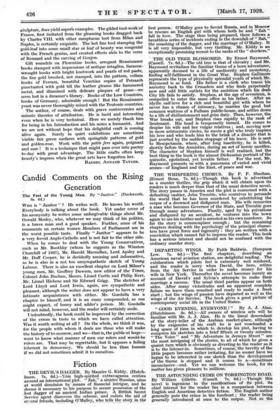An Historic Craft
Gothic and Renaissance Bookbindings. By E. Ph. Goldschmidt. Exemplified and Illustrated from the Author's Collection. Volume I.; Text. Volume II.: Plates. (Ernest Berm. £6 6s.) MR. GOLDSCHMIDT does. not concern himself with the unique books of history, those whose scripts lay within their covers
like relics in their reliquaries—covers charged with great goldsmith-work, for they were meant to lie like more jewels among the treasures of a queen, or to enter into the sacred
splendour around the High Altar of a Cathedral. Yet his two dignified volumes on the line craft of leatherwork as applied to
books that are typical survivors of groups handled in some
similar way, or wanderers whose haughty brand recalls a scattered library, are rich enough in historic suggestion to fascinate the general reader, even while they excite the collector, keen to dispute theories concerning the Aldine devices, or to covet his gathered specimens.
_ As the author shows his little masterpieces in blind stamp- work, euir eiseles, panel-work, dorures a petits fers, and vellum, the significance of the lovely objects affords unusual glimpses of the patient traditions that fed the flowering of European culture in the Renaissance. In quiet cells the Brethren of the Common Life multiply copies of the Gospels and stamp the leather to bind them. The brethren of the Reformed Orders, Benedictine, Carthusian, Dominican, through long hours assigned to their scriptoria, increase their manuscripts while others in the bindery work out the imagery of the cover. Then the printers set their presses in the mighty marts and seaports, Venice, Nurnberg, Antwerp, whence along the con- verging ways they diffuse their challenging wares in quires' and bales to the great University towns, where the binders wait in the restless academic quarters to finish the books to the buyers' fancy. Immense book-fairs, like those of Lyons and Frankfurt, draw their motley crowds. Great princes with echoing names, golden doges, humanist popes and cardinals, powerful bankers—all incite the artists of the book-eover. Matthew Corvinus, the warrior king of Hungary, fetches a craftsman from Naples to bind his volumes, feathering them with gold, heightening them with blue and red enamel. Moors and Jews in Cordova, Italians in France and Flanders, Greeks in Aldus Manutius's house in Venice, bend tirelessly over their fine leather, with simple definite tools making elaborate devices. Strange incidents keep the bookish trade adven- turous. John Fust flies from Paris with his Gutenberg Bibles, suspect of the Black Art. But the little Jew Mar-Jaffa may sit safely binding the Pentateuch for the City of Nurnberg in noble euir cisele with many a brave and splendid shape, but never one Christian symbol.
Iconoclasts have burned the beautiful" Gothic" books that shrined the written Word like the mystery it was. Eighteenth. century gentlemen have torn off their wrought romantic coats and forced them into habits of Versailles before they put them in their rococo libraries. The covers of books lost all their significance, as the little arts died before the Mechanical Age. But when Mr. Goldschmidt speaks with relishing exactitude of this scrupulous craft of bookbinding, in which the least dishonesty is fatal to beauty, he easily infects the reader with enthusiasm. To his mind the cuir tilde of South-cast Germany and of the Saracenic cordonniers in Spain is the noblest form of " Gothic " bookbinding, while the " dorures a petits fees" of the Valois period represent the finest effort of the Renais- sance decorators. The first, wherein the leather is often urged by pointed tool and sharp knife into a kind of heraldic seulptuie, does yield superb examples. The gilded tool-work of France, first imitated from the gleaming books dragged back by Charles VIII. with other sumptuous loot from Milan and Naples, is certainly exquisite. The hot fine tool stamping the gold-leaf into some small star oi leaf of beauty was congenial with the French genius, and created effects akin to the verse of Ronsard and the carving of Goujon.
Gilt roundels on Florentine books, arrogant Renaissance books stamped with impressions of antique intaglios, Saracen- wrought books with bright knotwork and pearls of red paste, the fine gold brushed, not stamped, into the pattern, vellum books of Ferrara, beautiful Venetian copies of Petrarch punctuated with gold till the leather gleams like hammered metal, and illumined with delicate plaques of gesso—we seem lost in a dreamer's library. Books of the Low Countries, books of Germany, admirable enough i But the Renaissance yeast was never thoroughly mixed with the Teutonic countries. The author, of course, deals with grave controversies and minute theories of attribution. He is lucid and interesting even when he is very technical. Here we merely thank him for being in his Introduction and his notes a humanist. And we are not without hope that his delightful craft is coming alive again. Surely in quiet exhibitions are sometimes 'visible fair green surfaces with springtide patterns of gold and golden-rose. Work with the petits fers again, poignant and sure ! It is a technique that Might pass over into poetry to-day with great advantage. The little crafts often keep beauty's impress when the great arts have forgotten her.
RACHEL ANNAND TAYLOR.











































 Previous page
Previous page